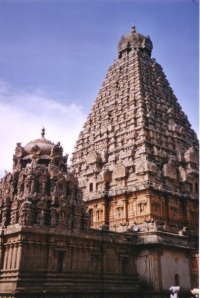The Cholas were a culture that built a strong foundation of sculpted architecture in 850 -1250 CE. They refined the styles of Dravidian art and created intricate bronze and stone sculptures and temples that were made to last for generations. During the middle period of their golden age, we can observe that projects and conquests of Rajendra Chola and his son; Rajendra Chola I. They built a number of temples in their culture’s unique architectural styles. Many ruins and remnants of these ancient structures still stand tall today because of their amazing engineering and design capabilities during the Chola period. One of these famous temples is the Tiruvalisvaram temple near Tirunelveli. These temples were of a very intricate and detailed design. From afar, they resembled the ascending orientation of Egyptian pyramids, but up close, a stylistic manner of sculpture and ornamental carvings can be visible to the eye.

Two of the greatest Chola temples are the Thanjavur and Gangaikondacholapuram. The first was completed around 1009 CE and is a memorial to the achievements made during the Rajendra reign. It is also the largest and tallest masterpiece in South Indian historical art culture. The two towers that surround the temple are called gopuras. Despite their massive size, the gopuras do not steal away the focus on the main temple itself because of the way they were constructed. The architecture revolves on the main temple through the flow of design composition within the entire complex. The Cholas were historically some of the best architects of their time, and today their incredible accomplishments still puzzle the modern world in more ways than even they could have imagined.
